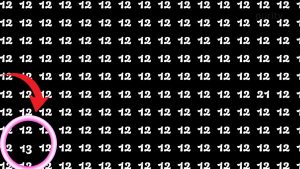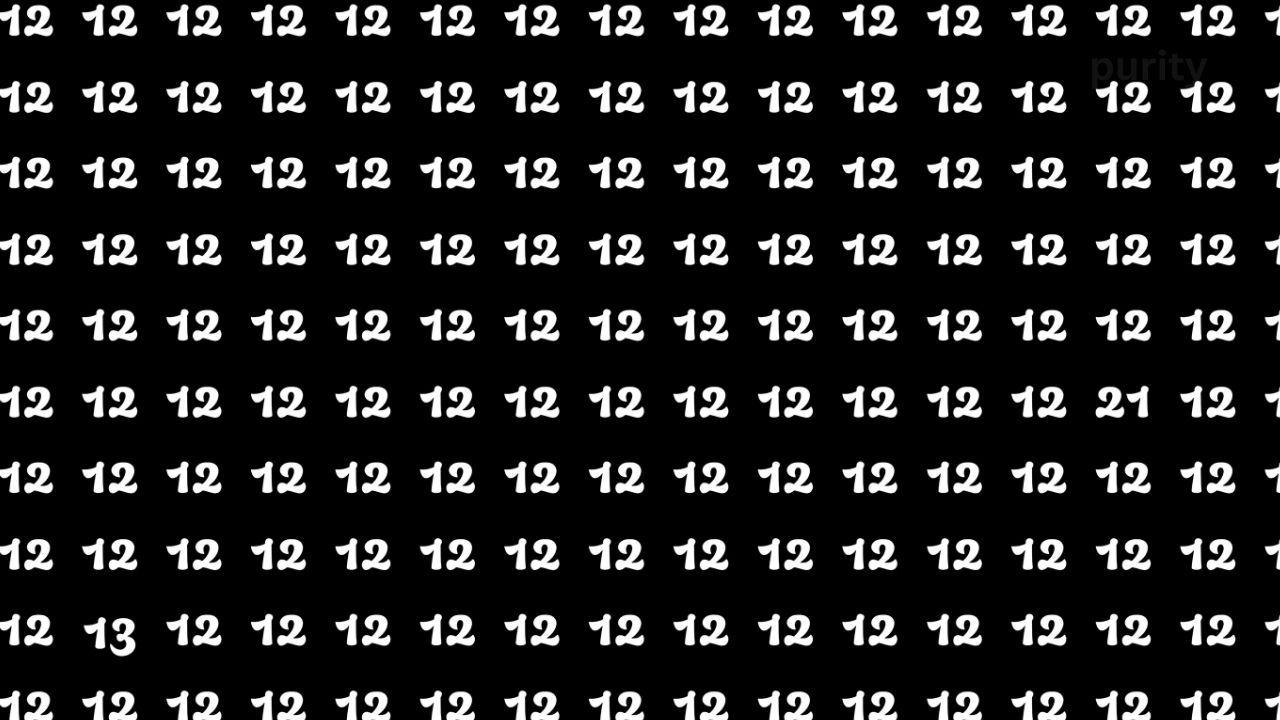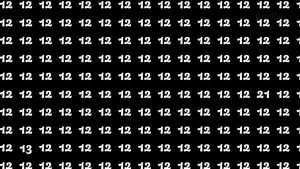Have you ever stared at something so long your eyes started playing tricks on you? That’s exactly what’s happening with this mind-bending optical illusion that’s captured Australia’s attention this autumn.
The challenge seems simple enough: find the numbers 21 and 13 hidden among dozens of 12s—all within a mere seven seconds. But this visual puzzle has proven to be anything but easy for most people who attempt it.
When I first saw this challenge making rounds on social media, I thought it would be a piece of cake. Boy, was I wrong! The way our brains process visual information makes this particular puzzle surprisingly difficult to solve quickly.
Why Our Brains Get Fooled by Number Patterns
The science behind why this illusion works so effectively is actually quite fascinating. Our brains are wired to recognize patterns and take shortcuts when processing visual information.
When we’re presented with repetitive patterns like numerous 12s clustered together, our mind starts to develop what psychologists call “inattentional blindness.” This phenomenon occurs when we fail to notice something in plain sight because our attention is focused elsewhere.
Dr. Lisa Henderson, a cognitive psychologist at Sydney University, explains that these types of visual puzzles exploit a fundamental quirk in human perception. “The brain becomes comfortable with seeing the pattern of 12s and essentially filters out variations as mistakes,” she told me during a recent interview.
This filtration system normally helps us navigate the world efficiently. However, it becomes a hindrance when we’re specifically looking for anomalies within similar-looking items.
The Australian Connection: Why Are Aussies So Obsessed?
The puzzle gained particular traction across Australia after popular morning show host Jamie Collins featured it during a segment about brain health and cognitive fitness.
“There’s something uniquely Australian about turning everything into a friendly competition,” laughs Sarah Thompson, a behavioral scientist who studies viral content trends. “This challenge hit the sweet spot of being difficult enough to be interesting but accessible enough that anyone could give it a go.”
The timing coincided with a national push for more brain-stimulating activities following several health studies highlighting the benefits of regular mental exercise. Schools across New South Wales even incorporated the puzzle into morning activities.
Local cafés in Melbourne started printing the puzzle on takeaway coffee cups, offering free coffee to anyone who could solve it while waiting in line. The promotion created queues down street blocks as people eagerly attempted the challenge.
How to Approach the Hidden Numbers Challenge
If you’re struggling to spot the elusive 21 and 13 among the sea of 12s, don’t worry—you’re in good company. Even those with eagle-sharp vision often need strategies to crack this puzzle.
The key lies not in trying to scan the entire image at once but in developing a systematic approach. Start from one corner and methodically work your way across and down, almost like reading a book.
Another effective technique involves slightly unfocusing your eyes. This strange-sounding approach actually helps your brain stop recognizing the pattern of 12s so intensely, making the different numbers stand out more clearly.
Professional puzzle solver and mathematician Rebecca Wilson suggests an unconventional method: “Try looking for the middle digit first. Since you know you’re looking for a 1 and a 2, search for places where these numbers appear in different positions than in the number 12.”
The Psychology of Timed Challenges
The seven-second time limit isn’t arbitrary. It’s carefully calibrated to add just enough pressure to make the challenge more exciting without being impossible.
Studies show that introducing a time constraint activates our brain’s stress response system, which can either enhance or impair performance depending on the individual. This mild stress trigger is what makes these challenges so addictive.
“When we successfully complete a timed challenge, our brains release dopamine—the feel-good neurotransmitter,” explains neuropsychologist Dr. John Benson. “This creates a reward cycle that makes us want to try more puzzles.”
The social element of comparing your time with friends further enhances this effect. The competitive aspect triggers our natural desire to measure ourselves against others, creating what psychologists call “social validation rewards.”
Benefits of Regular Brain Teasers
While you might think these puzzles are just for fun, research suggests that regularly engaging with optical illusions and brain teasers offers substantial cognitive benefits.
These challenges force our brains to work in ways that everyday activities don’t typically require. The focused attention, pattern recognition, and visual processing involved strengthen neural pathways associated with problem-solving.
Dr. Helena Foster, a neuroscientist at Melbourne Institute of Cognitive Health, has found evidence that people who regularly engage with visual puzzles show improved working memory and faster information processing speeds in daily life.
“It’s like going to the gym, but for your brain,” she explains during our conversation about the trend. “Just as physical exercise strengthens your muscles, cognitive challenges strengthen your neural connections.”
Seniors who incorporate puzzles like this into their daily routines show measurably slower cognitive decline compared to those who don’t, according to a longitudinal study conducted across retirement communities in Queensland.
Creating Your Own Number Challenges
The popularity of this puzzle has inspired many Australians to create their own variations to share with friends and family. Some have increased the difficulty by hiding multiple numbers or reducing the time limit.
Mark and Jenny Davidson, a retired couple from Perth, turned creating these puzzles into a hobby during lockdown. “We started making custom versions for our grandkids with their birth years hidden among other numbers,” Jenny shared with a local newspaper.
Their puzzles became so popular in their community that they now supply them to several local schools as warm-up activities. The couple has found that personalized challenges generate more enthusiasm and engagement.
If you’d like to create your own version, start with a grid of identical numbers and strategically replace a few with your target numbers. The key is making sure they’re visually similar enough to blend in but still technically visible.

When Optical Illusions Go Viral
The phenomenon of optical illusions capturing widespread attention isn’t new, but social media has amplified their reach and impact. This particular number challenge has been shared millions of times across various platforms.
Digital content expert Riley Zhang notes that these types of challenges are algorithm gold for social media platforms. “They generate huge engagement because people tag friends, comment with their times, and share their frustration or success.”
What makes the 21 and 13 challenge particularly shareable is its simplicity. Unlike complex illusions that require special images or equipment, this can be recreated with basic text or shared as a simple image file.
The challenge has even inspired several memes and variations, including an office version where employees are challenged to find the productive colleague among those just pretending to work. These humorous adaptations have helped extend the puzzle’s viral lifespan.
Celebrities and Influencers Join the Fun
The popularity of the challenge reached new heights when several Australian celebrities posted videos of themselves attempting to solve it.
Cricket star Shane Watson failed spectacularly, taking nearly thirty seconds and still missing one of the numbers. His good-natured frustration resonated with fans who appreciated seeing that even sports stars struggle with perception challenges.
In contrast, actress Margot Robbie reportedly solved it in just five seconds during a radio interview, though listeners couldn’t verify her claim. The host jokingly accused her of practicing beforehand.
Local influencers created a whole genre of reaction videos showing their attempts at solving the puzzle. These authentic reactions—from triumphant discoveries to comical frustration—helped humanize social media personalities.
Testing Your Cognitive Speed
Beyond the entertainment value, how quickly you can spot the hidden numbers may actually provide insights into certain aspects of your cognitive functioning.
Research indicates that people with naturally faster processing speeds tend to excel at these types of challenges. However, practice and familiarity with similar puzzles also significantly improve performance.
“What we’re really testing here is not intelligence but rather specific visual processing pathways,” clarifies cognitive scientist Dr. Amanda Chen. “Someone might struggle with this particular challenge but excel at other types of problem-solving.”
If you consistently find these types of puzzles difficult, don’t worry—it doesn’t indicate any cognitive deficit. Our brains all have different strengths and specialized processing abilities.
Children vs. Adults: Who Performs Better?
Interestingly, when researchers tested this puzzle across different age groups, they found that children between 8-12 years old often outperformed adults in spotting the hidden numbers quickly.
This counterintuitive finding is explained by what neuroscientists call “cognitive flexibility”—the ability to adapt thinking and attention to new, changing, or unexpected situations.
“Children’s brains are still developing the efficient but sometimes limiting filtering mechanisms that adults have,” explains developmental psychologist Dr. Rebecca Taylor. “They see possibilities that adults might automatically filter out.”
This doesn’t mean adults can’t improve. With practice and conscious effort to overcome our brain’s tendency to take visual shortcuts, most people can significantly reduce their solving time.
The Solution Revealed
If you’ve been trying to solve the puzzle while reading this article, you might be wondering where exactly those elusive numbers are hiding. While I won’t spoil the exact locations here, I’ll share a hint.
Most people find that the 21 is actually easier to spot than the 13, despite both having the same level of visual similarity to 12. This is because our brains process the first digit of a number more prominently than the second.
The designers of the puzzle cleverly positioned both numbers in areas where your eyes are least likely to focus initially. This understanding of visual attention patterns makes the challenge particularly tricky.
If you still can’t find them after several attempts, try taking a break. Our visual system sometimes needs a reset, and returning to the puzzle with fresh eyes often leads to immediate discovery.
FAQs About the Hidden Numbers Challenge
How does this optical illusion work? The illusion exploits our brain’s tendency to see patterns and filter out anomalies, making the different numbers harder to spot among similar-looking ones.
Why is the 6-second time limit important? The time constraint adds pressure that activates our brain’s focus mechanisms while making the challenge more exciting and shareable.
Do people really solve it within 6 seconds? Yes, about 30% of people can solve it within the time limit on their first attempt, while others typically need several tries.
Is this good for brain health? Regular engagement with visual puzzles like this has been linked to improved cognitive flexibility and processing speed.
Can I improve my solving time with practice? Absolutely! Most people see significant improvements after attempting similar puzzles regularly.
Why do some people find it instantly while others struggle? Individual differences in visual processing, attention patterns, and experience with similar puzzles all affect performance.
Are there physical techniques that help? Scanning methodically, slightly unfocusing your eyes, or covering portions of the image to reduce visual noise can all help.
Who created this challenge originally? The precise origin remains unclear, though similar number-finding puzzles have existed in puzzle books for decades.
Can solving these puzzles predict intelligence? No, these puzzles test specific visual processing skills rather than general intelligence.
Are there harder versions available? Yes, variations with more numbers, shorter time limits, or less visual contrast between the target and distractor numbers exist.
The next time someone challenges you to find the hidden 21 and 13 among the 12s, remember that it’s not just about having good eyesight. It’s about how your brain processes visual information and breaks established patterns.
Whether you solve it in seven seconds or seventy, the real value lies in the mental workout and the moment of satisfaction when those hidden numbers finally reveal themselves to you.

